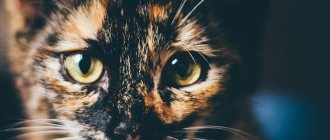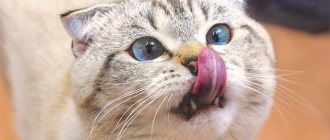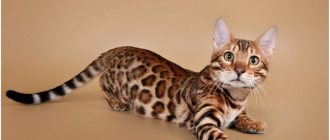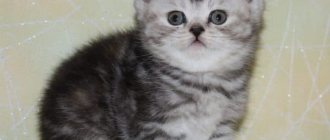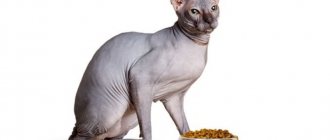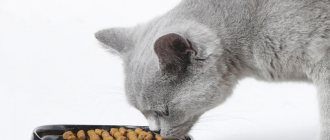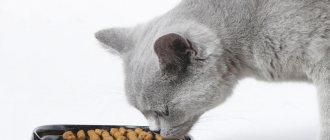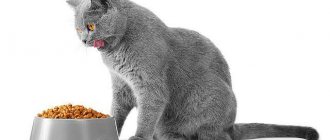The Bengal cat is one of the most ancient breeds, whose mesmerizing color of the representative dates back to the past times of the cat family. They look like animals in the wild, foraging for their own food. Many years have passed, these pets have turned into domestic cats with an attractive appearance and playful disposition.
Bengals are larger in size and weight than all other cats, their average weight reaches 7-8 kilograms. Despite their “severe” appearance, they are gifted with a sensitive digestive system, so cats must be kept strictly according to the instructions. Let's look at the basic principles of what and how to feed domestic Bengal cats.
Basic nutritional features
In the wild, Bengal cats feed mainly on rodents and marsupials. These “products” can be replaced at home with different types of meat. For this breed, it is important that at least 70% of the total portion is meat.
The raw product is more beneficial for the animal. Since the likelihood of becoming infected with parasites from eating raw meat every day is very high, it is important to first freeze the meat in the freezer for at least 5 days.
Food for animals should be as fresh as possible. If the portion for your pet turns out to be too large and not finished, it should be thrown away and not left “for later.” All dishes should be neither hot nor cold. It is necessary that the food is at room temperature. Before giving meat from the freezer to the cat, it is recommended to pour boiling water over it and cut into small pieces.
The pet must know its place for feeding, as well as meal times. It is not allowed to give any snacks in response to an animal's begging.
Bengal cats can eat both natural products and ready-made premium commercial diets. It is not recommended to combine dry food with canned food or raw meat.
How to switch to a different type of feeding or other foods
Adding new products to the diet, switching to any new food - dry or wet, and even more so changing the type of feeding - is a very important moment for the proper nutrition of a Bengal cat. The process should be carried out step by step, with observation and great care. Experts have developed an algorithm for this, adhering to which the owner will not harm the animal. The procedure for introducing food new to a Bengali is as follows:
- first and second days: the cat is offered only 20-25 percent of unfamiliar food;
- the third and fourth days, if no problems are found, the usual and new food are given in equal shares;
- on the fifth day you can try a 100% transition to a new diet.
All this time you need to monitor the well-being of the Bengal cat and take an interest in the contents of its potty. In case of alarming symptoms (loose stools or constipation, spotting, refusal to eat), you should return to the previously tested method of feeding, to the previous foods.
The owner decides how best to feed his Bengal pet. However, if you strictly follow the described recommendations, then even with such a feature of the genetics of Bengal cats as an overly sensitive stomach, no special troubles with feeding are expected. You just need to pay a little more attention to the diet and, most importantly, the quality of food than representatives of other breeds. Proper nutrition is the key to a long and happy life for a Bengal cat.
Diet
As a rule, representatives of the breed are not prone to excess weight. When creating a diet, you should also not forget about the anatomically shortened intestines, which means rapid digestion of food. The optimal number of meals is calculated according to the age of the pet:
- up to 1 month – upon request;
- 1-2 months – 5-6 times a day;
- 2-3 months – 4-5 times;
- 4-5 months – 3-4 times a day;
- from 6 months and adults – 2 times a day.
Other recommendations
When a kitten is weaned from its mother's breast, it is especially necessary to carefully monitor its nutrition. Typically, Bengals from three years old are fed five times a day in small portions. Its size, sexual function, activity and health will depend on a balanced and healthy diet (see size and weight of a Bengal cat).
But you shouldn’t think that if the kitten has grown up healthy and beautiful, then you can give up on its nutrition. His further appearance and well-being depend on this.
What to feed a Bengal kitten
Like other cat breeds, Bengal cat babies must be fed exclusively on mother's milk for the first 4-5 weeks of their lives. At this stage, it is quite enough to obtain the necessary useful elements. For the mother cat herself during this period, special ready-made premium or holistic foods are more suitable.
From the first month of life, little “predator leopards” can already try some natural products. Experienced veterinarians recommend taking thawed and chopped meat, high-quality homemade minced meat or meat porridge cooked in water as the first complementary food.
Over time, you can offer kittens larger pieces of meat. As an option, you can use delicate ready-made pates and mousses that are made for animals of this age.
The second optimal product for complementary feeding is cottage cheese. Since it can be difficult for a baby to swallow, it is worth diluting it with low-fat milk or homemade yogurt. The animal should be accustomed to vegetables last.
Bengal cats must eat kitten food until they are 8-12 months old. After a year, they can switch to adult food.
Feeding newborns and very young cats
Newborn kittens are almost never sold, because they are very difficult to care for and feed. This burden falls entirely on the kitten's mother. She will do the best job feeding a young Bengal.
The cat feeds very small Bengals
If there is no cat, but the kitten still comes to you, then you will have to watch it especially closely. You need to feed a kitten that is not even a month old with milk. Special mixtures and cat milk substitutes work well. I can recommend “KITTY-MILK” from Beaphar.
KITTY-MILK
The same powder can be used for additional feeding of kittens that feed on mother's milk. Many experts consider this substitute to be one of the best. Feed should be strictly according to the instructions.
Kittens from 1 to 4 days should be given 30 ml. mixtures per day per 100 grams of their weight.
When your pets are 5-13 days old, you can give them 38 ml. mixture per 100 grams of their weight, thereby gradually increasing the dose of nutrients.
What to feed a Bengal kitten who is two months old
Once they reach two months, kittens are fed more than just milk. An excellent option would be to start feeding him what is natural for him in nature - meat. But it needs to be prepared in a certain way, so as not to harm the kitten. At first, it is better to boil the meat, then cut it into very small pieces.
But in nature, no one cooks meat for cats, so you can give raw meat, in which case it will need to be frozen for a long time. At first, it’s better to play it safe and leave it in the refrigerator for several days or weeks. Then a thin layer is removed from the meat using a knife. The resulting shavings are doused with boiling water and given to the kitten.
Bengal at 2 months
Another good option would be porridge with meat, for example, rice. It should be given with plenty of water or milk. The finished product should resemble a thick substance.
Natural food for an adult Bengal cat
Some owners prefer natural feeding. When preparing daily dishes for your Bengal, it is important to consider that the following products should be present in his diet:
- Meat . The optimal daily volume of meat is 60-65% of the total volume. A lack of proteins and other substances necessary for the normal development and growth of a pet occurs when the meat volume decreases to 40-45%. Pre-frozen and then scalded pieces of raw meat are ideal for Bengals - for example, chicken, rabbit, veal, chicken necks.
- Offal . With great pleasure, Bengal cats eat raw hearts, gizzards, tripe, kidneys and lungs. They, like meat, must first be frozen in the freezer and then scalded in boiling water.
- Fish . Allowed once a week. It is recommended to give preference to sea fish, previously boiled and deboned.
- Dairy and fermented milk products . Adult Bengals are happy to try cream with a fat content of up to 20%, as well as low-fat yoghurts, fermented baked milk, kefir and cottage cheese.
- Eggs . Bengals refuse boiled eggs. Therefore, the best option for them would be raw quail egg yolks. They can be given no more often than 1-2 times every 7 days.
- Vegetables . The share of vegetables in the total serving should be no more than 20%. Carrots, zucchini, beets, and sweet peppers are allowed to be given both raw and boiled.
- Cereals . They will be an excellent addition to the diet, but their norm should be limited to 5-7% of the total serving per day.
- Greenery. Added to dishes (porridge, minced meat) as an additional source of vitamins: spinach, lettuce, sprouted grass.
Natural feeding of a Bengal cat should be supplemented by periodic intake of mineral and vitamin complexes, since it is impossible to fully compensate for the lack of beneficial minerals from food.
List of contraindicated products
When developing a diet for your kitten, do not forget that some foods are simply contraindicated for him. These primarily include milk - it causes stomach upset. But yogurts, kefir and yogurt will become an important source of protein.
You should immediately give up potatoes and eggplants - Bengals tolerate them very poorly.
Also, don't get carried away with fish. In the wild, Bengal cats eat it extremely rarely, and therefore are not very adapted to digest it. In addition, frequent consumption of fish causes serious problems with the urinary system.
The best ready-made diets
Having analyzed the cat food market, veterinary specialists and breeders have identified the most optimal production rations that best satisfy the needs and characteristics of purebred representatives.
- WildCat Etosha . Dry natural food from a German manufacturer. Belongs to the category of holistic products, that is, the most balanced products. It is distinguished by its high protein content (approximately 46%) and the presence of flaxseeds.
- Orijen Six Fish Cat . Canadian food based on fish products. Rich in proteins. Also includes vegetables, fruits, grain products.
- CARNILOVE Salmon for Adult Cats . This food is made by a Czech manufacturer. Created specifically for those breeds of cats that are as close as possible to their predatory ancestors. 36% consists of crude protein.
- Royal Canin Bengal Adult . Premium product from a French company. Ideal for Bengals over one year of age. 40% consists of proteins.
- Eukanuba Adult with Chicken . Quality product from the Netherlands. It is high in protein and also includes fatty acids and probiotics.
Ready-made foods are also great for small kittens, for example, from Brit Care, Fitmin For Life, Leonardo, Summit.
If the owner has opted for finished products, it is important to ensure that the pet has constant access to fresh water. In addition, the owner should not feed the Bengal with vitamins, since food from the holistic and super-premium categories contains the daily requirement of all minerals. Otherwise, hypervitaminosis will occur, which causes discomfort and discomfort in the pet.
Tags
Bengal catheritage bengal catrecommended for bengal cats.for bengal catswhy the bengal breed bengal breedhistory of the bengal catrainbows of bengal catsyour bengal catfeeding the bengal catAbout the cat behind the cat the bengal cat has received masses of the cat.Bengal cats.the cat always and cats need an adult cat.the well-being of the cat after should a cat ask about kitten after kitten feeding a kitten Raising a kitten, treating a kitten
catfollowbonesmorediseasedogsotherchickenreadnoscript

